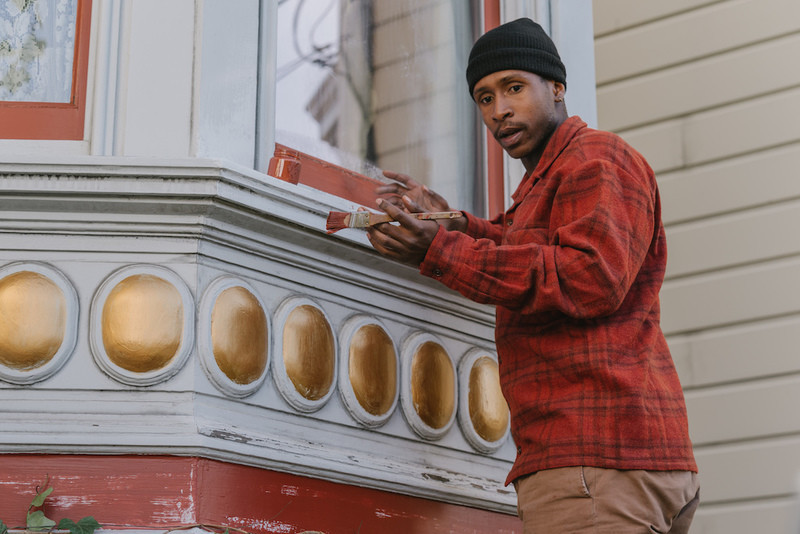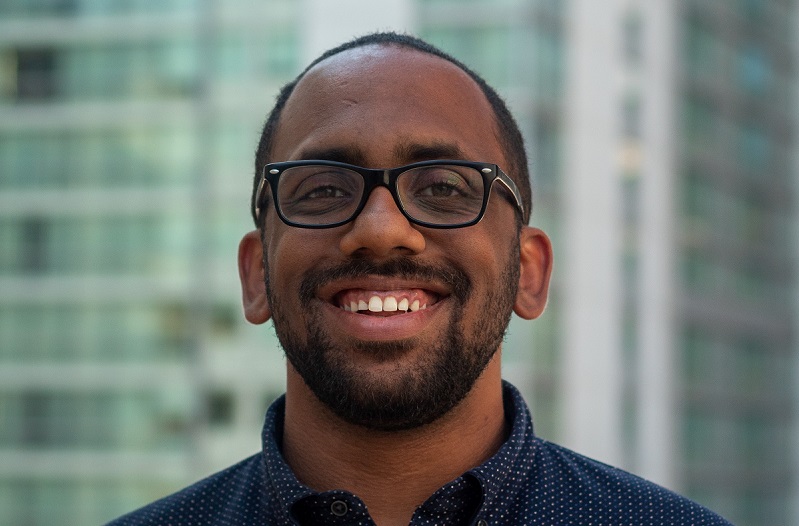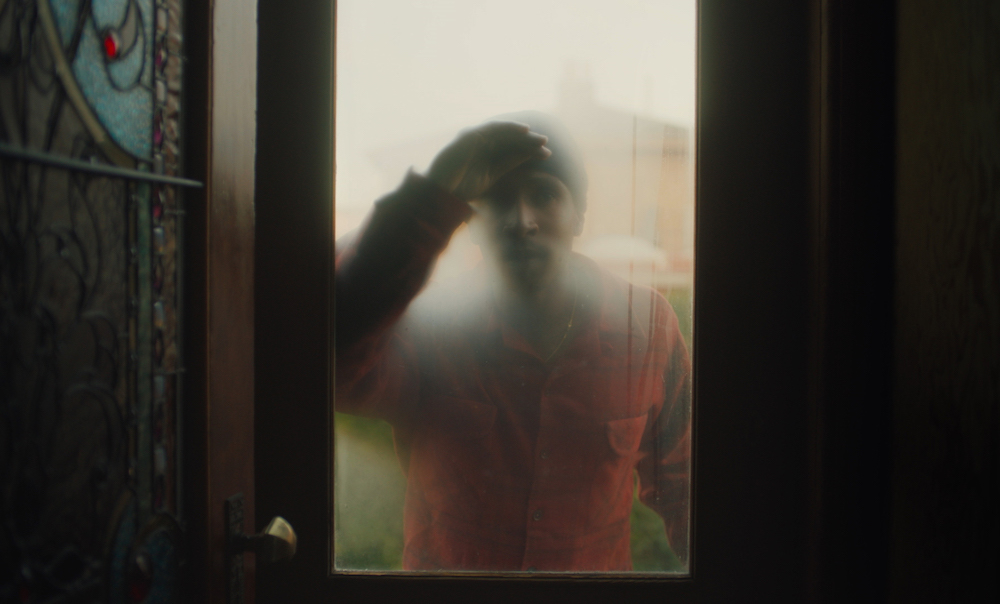We are republishing this piece on the homepage in allegiance with a critical American movement that upholds Black voices. For a growing resource list with information on where you can donate, connect with activists, learn more about the protests, and find anti-racism reading, click here. “The Last Black Man in San Francisco” is currently streaming on Amazon and Kanopy. #BlackLivesMatter.
Two young Black men, Jimmie (Jimmie Fails) and his best friend Montgomery (Jonathan Majors), warmly tend to Jimmie’s former family home in San Francisco: the proverbial sanctuary, a white-tiled Victorian house surrounded by an ivy-covered gate, containing an organ, topped with a witch-hat roof. They return to the now white-owned house every two weeks for touch-up work—a new coat of paint here, a trim of the weeds there—ritually serving a home whose new white masters, as Jimmie and Montgomery perceive, treat the house as a mere edifice.
Director Joe Talbot’s “The Last Black Man in San Francisco” follows Jimmie and Montgomery’s struggle to retake the former’s family home, and overcome the origins of gentrification. Gentrification thrives today due to decades of desperate Black families forced into the vulnerable system of renting, where the chances of eviction rises with each prevailing hardship. To understand Jimmie’s quest to regain his family home, one must first understand the nefarious results of the GI Bill as they relate to his grandfather, and the importance of homeownership within the Black community.
“Home ownership … an emblem of American citizenship … was not to be awarded to Blacks,” explains Ta-Nehisi Coates in his essay The Case for Reparations. Housing in America, a passport to a middle-class existence, remains unstamped even today for struggling Blacks. A holdover of sharecropping, when former slaves were promised 40 acres and a mule, the convent of homeownership for Blacks stands unfulfilled through decades of structural racism led by carpetbaggers (the proverbial highwaymen disguised as “fair-minded” bankers) and extralegal laws.

However, post-World War II America offered a tantalizing opportunity for returning Black soldiers. The newly-passed GI Bill (1944) gave returning servicemen the option to borrow government guaranteed loans to purchase homes or farms. Blacks, like Jimmie’s grandfather, hoped the new legislation would disintegrate the previous racist banking practices blockading them from owning homes.
For many Blacks, predatory loans represented the only option to purchase a home. Real estate agents bought houses on the cheap and sold homes “on contract,” meaning: one missed or tardy installment routinely led to an eviction of the current Black homeowners, with the same house later selling to the next unsuspecting and desperate Black family for a higher price.
In “The Last Black Man in San Francisco,” Jimmie believes his grandfather refused to take a home seized from a Japanese family and instead built his own (presumably with a loan through the GI Bill), something that Jimmie magnanimously explains from the building’s portico to a group of white Segway tourists below. But later in the film, a white realtor reveals the unnerving truth: Gill Cooley constructed the home in 1857, rather than Jimmie’s grandfather in 1946 (telling between antebellum and post-war America). Desperate for the last full measure of citizenship, Blacks have time-and-again been relegated to a second-class existence. Jimmie eventually realizes he’s relegated himself to the same fate, dutifully buying into the fantasy offered by America and his grandfather.
Jimmie’s father, James Sr. (Rob Morgan), caused the family to lose the house with his embittered drug habit, but he too believes in the myth, describing the elder-Fails as “the first Black man in San Francisco.” And like his son, James Sr. attaches much of his self-worth to the home, making him bitter and distrustful. The hurt felt by James Sr. should prove familiar to many Black families: My father regretted not owning a home until his dying day, regretted not providing his family with more stability, which produced a cynical outlook in him. As for James Sr., his hurt causes him to believe in the hustle: Because “you don’t own shit.” The maxim proves reliable considering the family’s past, as Jimmie’s grandfather probably fell prey to an extralegal-housing system where he never fully owned his home, making the loss of such by the next generation, James Sr., easy.
To further explain the importance of homeownership, Talbot also introduces a Greek chorus of hyper-masculine thugs standing on the corner of Montgomery’s grandfather’s house. Living on the Westside of Chicago, many of my friends plunged from stable home lives to street corners due to several familial setbacks. In Talbot’s film, one of the men is gunned down for “talking shit.” Unfazed by white homeowners, the precarious footing of renting causes the margin of error for Black families to rarely rise above zero. This leads to generations of young Black men and women tumbling into a cycle of poverty and death.

Conversely, Montgomery is well-read, and we assume his blind grandfather (Danny Glover) owns their home. The stability makes Montgomery separate from the aggressive men hanging outside; they describe Montgomery as “weird.” However, even his grandfather’s home is relatively small, evinced by Montgomery’s walk-in-closet-sized room. When a Black man attains homeownership, their dwelling usually occupies a dilapidated neighborhood, a result of redlining.
Unlike renting, homes carry transferable wealth, leverage-able to send children to college or cover medical expenses, or as an inheritance. The older white couple occupying Jimmie’s “home” forcibly leave due to an estate battle, a skirmish for said transferable wealth. America is a kleptocracy, as Ta-Nehisi Coates once surmised, and Jimmie employs the country’s tactics. He moves into the vacant home overnight, hoping to live there while what he presumes will be a prolonged estate battle plays out.
Like Jimmie’s plan, his grandfather triumphing over the oppressive and unfair system of homeownership reads like a soon-to-be-broken myth. Jimmie tethers himself to his grandfather’s “victory.” As a child, he recounts his grandfather’s story to the other children, and later to Montgomery as an adult. His waking dream could only be a dream, only evoked as such to viewers through Talbot’s long shots of Jimmie skateboarding down San Francisco’s hilly streets as gleaming buildings rise around him, trapping him within this near-inescapable gentrified nightmare.

Jimmie’s self-worth and the home are evocatively tied. Talbot and editor David Marks employ striking associative editing, connecting the home’s features with Jimmie’s. The rain dripping from siding is to the sweat falling from Jimmie’s face, and a window’s gilded trim is to his gold chain. Talbot’s exterior shots often frame several other characters within portions of buildings: Montgomery standing behind a window of Jimmie’s house or Jimmie’s father sitting on the windowsill of an SRO hotel.
While Talbot and Fails’ film depicts other “playful” threats to Blacks—a bay polluted by nuclear waste surrounding these exiled San Franciscans (a slight allusion to Flint, Michigan)—Talbot’s elegant tracking shots pull past tableaus of Black existence: children frolicking, friends laughing, old men playing dominoes. These shots demonstrate how Black families, even with the weight of structural racism weighing down futures, possess minds not changed by place or time. Jimmie adopts this survival mechanism, the mechanism that says to live and move on.
In a final scene conjuring a hymnal catharsis from Emile Mosseri’s choir-driven score, Jimmie rows away from San Francisco’s murky shores in a boat. The story of Black America began in boats, Jimmie’s future becomes reborn in those same churning waters. And much like Jimmie’s grandfather, Talbot and Fails offer Jimmie a fairy tale: the freedom of sailing away from the dangerous neighborhoods, the extralegal real estate system, and the white homeowners who don’t know how good they’ve got it in “the San Francisco they never knew existed.” San Francisco doesn’t deserve Jimmie; America doesn’t deserve generations of hardworking Blacks.
“The Last Black Man in San Francisco” is currently streaming on Amazon.












